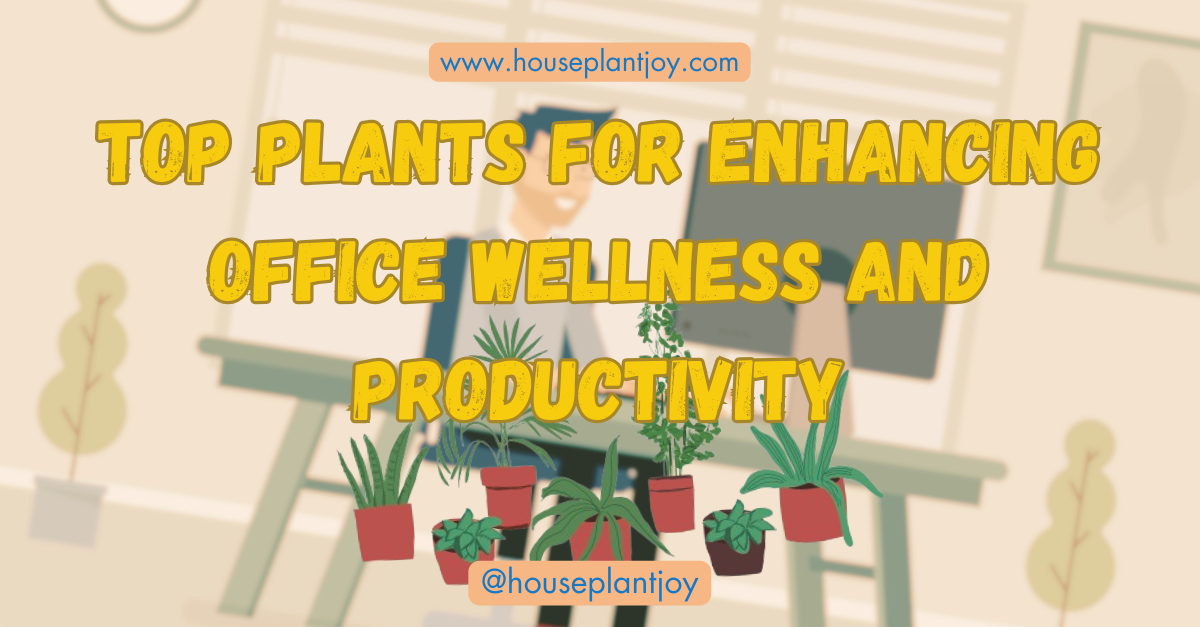HousePlantJoy is supported by our audience. When you purchase through one of our links, we may earn a small affiliate commission. As an Amazon Associate I earn from qualifying purchases. Your cost is not affected.
==================
Ever notice how work can sometimes leave you tired and stressed? Many offices miss out on something simple that can help – plants. Our workplaces often lack a touch of nature, affecting our well-being. This guide is here to tackle that issue. It’s a solution to make your office a better place for you. We’ll show you the top plants for enhancing office wellness and productivity, making your air cleaner and your day less stressful. Let’s make your workspace a healthier and more enjoyable space.
In these pages, we’ll explore simple ways to bring in plants to improve the air you breathe, reduce stress, and boost your creativity. Let’s turn your workspace into a healthier and happier environment together.
Greening Your Work Space: The Top Plants for Enhancing Office Wellness and Productivity
Transforming your workspace into a green haven isn’t just about aesthetics; it’s about creating a healthier, more vibrant place that can enhance your well-being and productivity. Incorporating plants into your office environment offers numerous benefits, from improving air quality to reducing stress. Selecting the right plants to thrive in your office’s specific conditions is crucial to maximizing these advantages.
Setting up a green space in your work area goes beyond placing a few potted plants on desks. It involves understanding how plants can positively impact your work environment, integrating them seamlessly with the technology in your office, and fostering an eco-friendly office culture. Overcoming challenges such as limited space or light and ensuring your plants receive proper care are part of creating an inspiring and sustainable green workspace.
Key Takeaways
- Plants contribute to a healthier and more productive office environment.
- Choosing suitable plants and their proper care are essential for a thriving green space.
- A green workspace links well-being with an eco-friendly office culture.
The Basics of Office Greening
When you incorporate plants into your office, you’re stepping towards a healthier and more vibrant work environment. Selecting the right plants is essential. Opt for low-maintenance varieties such as snake plants or pothos, which can thrive with minimal care.
Lighting is crucial for the health of your plants. Assess the natural light available in your office and place plants accordingly. If natural light is scarce, consider shade-tolerant plants or use artificial plant lights.
Here’s a quick checklist to get you started:
- Identify the lighting situation: sunny, partial shade, or low light.
- Choose appropriate plants:
- Sunny: Spider plants, jade, or aloe vera.
- Partial shade: Philodendron, peace lily, or bamboo palm.
- Low light: ZZ plants or ferns.
Remember to water your plants as needed. Over-watering can be as harmful as under-watering, so please understand the water requirements for each plant type.
The quality of air also affects plant growth. Most indoor plants improve air quality, but some are particularly effective, such as the rubber plant or Boston fern.
Lastly, consider how the plants will fit into your office space. Use decorative pots or hanging planters to maximize space and add aesthetic appeal.
Choosing the Right Plants for Your Office
Selecting the right plants for your office can enhance your work environment significantly. Certain species thrive in office conditions, improve air quality, and are safe for office pets.
Low Light Tolerance Species
Consider plants that prosper in low light if your office lacks natural sunlight. The ZZ plant (Zamioculcas zamiifolia) is renowned for surviving in dim conditions and minimal water. Similarly, the snake plant (Sansevieria trifasciata) maintains its resilience even in sparingly lit spaces. These plants can stay healthy with fluorescent lighting often found in offices.
Air-Purifying Varieties
Creating a cleaner air environment is another great reason to bring plants into your workspace. The spider plant (Chlorophytum comosum) is known for its air-purifying abilities, effectively reducing indoor pollutants. The peace lily (Spathiphyllum sp.) not only blooms beautiful flowers but also ranks high in eliminating airborne toxins, making it an ideal office plant.
Non-Toxic Plants for Pet-Friendly Offices
In offices that welcome pets, it’s vital to choose non-toxic plants. The Boston fern (Nephrolepis exaltata) is a safe option, adding lush greenery with its feathery leaves. The areca palm (Dypsis lutescens) is another pet-friendly plant recognized for its non-toxic leaves and charismatic appearance. Please ensure these plants are within reach of your four-legged coworkers to keep them out of harm’s way.
Health Benefits of Office Plants
Adding plants to your office can transform your work environment by reducing stress, purifying the air, and boosting productivity.
Stress Reduction
Office plants are not only attractive to look at, but they also have a significant impact on reducing stress. A study by the University of Technology, Sydney, highlighted a 37% decrease in tension and anxiety when plants were introduced to the office. Your stress levels could drop by having a bit of greenery in your view.
Improved Air Quality
Indoor plants can act as natural air filters, absorbing toxins and emitting oxygen. They improve the overall air quality around your desk. For example, snake and spider plants are particularly effective, producing fresher, cleaner air to breathe while working.
Enhanced Productivity
Your cognitive tasks might get a considerable boost from plants in the office. According to research, having plants in your workplace can significantly increase your productivity levels. This uplift in performance might be linked to the improved air quality plants provide and the psychological effects of being closer to nature.
Setting Up Your Green Space
Creating a green space in your office can enhance aesthetic appeal and improve air quality. Thoughtful placement, proper containers, and regular maintenance are crucial to integrating plants seamlessly into your workspace.
Space Planning for Plant Arrangements
Begin by evaluating the light levels and available space in your office. Place low-light plants like snake plants near windows facing north or in fluorescent-light areas. Reserve sunnier spots by south and west-facing windows for plants that thrive in full sun, like succulents. Here is a simple guide:
- Low-light areas: ferns, pothos, and philodendrons.
- Medium-light areas: spider plants and peace lilies.
- Bright-light areas: cacti and most succulents.
Ensure each plant has enough space for growth and airflow, preventing mold and plant diseases.
Selecting Containers and Accessories
You can choose containers that complement your office decor and suit the needs of each plant. For example, terra-cotta pots are excellent for succulents since they allow soil to dry out more quickly, but they might be better for moisture-loving plants. Consider self-watering planters if you have a busy schedule. Additionally, invest in saucers to protect your office surfaces from water damage.
Ongoing Care and Maintenance Tips
Establish a care routine based on the specific needs of your plants. Most will benefit from:
- Watering: when the top inch of soil feels dry.
- Feeding: with a balanced, water-soluble fertilizer every six weeks during the growing season.
- Pruning: to remove dead or yellowing leaves.
Monitor your plants for pests and signs of distress, like leaf drop or wilting, which could indicate over or under-watering. Adapting your care will keep your plants thriving and your green space lush.
Remember, a healthy green space results from ongoing attention and adjustments to meet the needs of your plants.
Integrating Technology with Office Greening
In modern office environments, technology is vital in sustaining plant life efficiently. Smart systems streamline the care of your office greenery and optimize plant growth for a healthier working space.
Automated Watering Systems
Key Aspects:
- Consistency: You ensure that your plants receive the precise amount of water at the proper intervals without manually watering them.
- Efficiency: Save time and resources by minimizing water wastage with systems that adjust watering based on humidity and soil moisture levels.
Best Practices:
- Installation: Choose a system that integrates easily with your existing office setup.
- Maintenance: Opt for systems with easy maintenance requirements to ensure long-term reliability.
Growth-Encouraging Light Solutions
Types of Lights:
- LED Grow Lights: Offer a full spectrum, mimicking natural sunlight to promote photosynthesis.
- Adjustable Light Systems: This allows you to alter intensity and duration according to the specific needs of your office plants.
Benefits:
- Healthy Growth: Plants thrive under optimal lighting conditions, essential in offices that may lack natural sunlight.
- Energy Savings: Efficient lighting solutions consume less power, reducing your office’s environmental footprint.
Integrating these technological advancements into your office greening efforts enhances plant vitality and contributes to a more dynamic and healthy workspace.
Overcoming Challenges in Office Greening
Implementing greenery in your office can cause obstacles such as unwanted pests and low-light conditions. These challenges can be addressed with the right strategies, ensuring your office plants remain healthy and beneficial.
Dealing with Pests and Diseases
Prevention is your first line of defense against pests and diseases. Regularly inspect your plants for signs of trouble, such as discolored leaves or sluggish growth. If you detect pests like aphids or spider mites, isolate the affected plant to prevent spread. For diseases, remove any infected parts and dispose of them immediately to protect the remaining foliage.
- Natural Remedies:
- Use neem oil or insecticidal soap for mild infestations.
- Introduce beneficial insects like ladybugs that prey on common pests.
Remember, overwatering can lead to root rot and other issues, so ensure your plants have proper drainage and you adhere to their watering requirements.
Addressing Inadequate Natural Lighting
Not every office space is blessed with an abundance of sunlight. Plants that thrive in low-light conditions can be a practical solution.
- Low-light Plant Options:
- Snake Plant
- ZZ Plant
- Pothos
Alternatively, invest in grow lights that simulate natural light, choosing those that offer the full spectrum for your plants’ photosynthesis needs. Position your plants where they can receive the maximum available natural light without exposing them to harsh direct sunlight that may damage them.
Inspiring an Eco-Friendly Office Culture
Fostering an eco-friendly office culture goes beyond just adding plants to your workspace. It’s about engaging your colleagues and integrating sustainable practices into everyday office life to create a greener and more efficient environment.
Encouraging Colleague Participation
Start with education: By providing resources and workshops, you can inform your team about the importance of sustainability. Highlight success stories of eco-friendly programs to motivate participation.
- Host Eco Challenges: Stimulate friendly competition by creating monthly challenges that reward sustainable behaviors.
- Recognition Programs: Acknowledge the efforts of colleagues who lead by example in embracing eco-friendly practices.
Promoting Sustainability Practices
Emphasize the significance of individual actions that contribute to a more significant impact.
- Waste Reduction: Implement policies to minimize waste and provide clear instructions for recycling. Opt for reusable kitchen supplies and encourage digital documentation over paper use.
- Energy Efficiency: Equip your office with energy-efficient appliances and implement strict shutdown policies after work hours to conserve energy.
By integrating these specific strategies, you create a workplace that not only talks the green talk but also walks the walk toward a more sustainable future.
Resource List for Office Greening
When you decide to integrate plants into your office, you’ll need various resources to guide you and ensure the sustainability of your green space. Here’s a concise list to get you started:
- Digital Transition: Reduce paper usage by going digital. Offices use thousands of sheets of paper annually, much of which is wasted.
- Plant Selection: For those with a busy schedule or a less-than-green thumb, cacti, and succulents are a low-maintenance choice that thrives in natural light.
- Benefits of Plants: Understand the multiple benefits of having plants in your workspace, including well-being, health, and productivity, by checking out this resource.
- Green Office Model: Learn about the green office concept to build a sustainable environmental management system at your workplace here.
- Well-being and Plants: Dive into how plants can increase concentration and reduce absenteeism, thereby boosting employee well-being with insights from Corporate Wellness Magazine.
Remember, these resources will help guide your decisions and actions as you transform your office into a greener, more sustainable environment.
Success Stories: Case Studies of Green Workspaces
You might be intrigued by how green spaces positively impact work environments. Numerous organizations have adopted greener offices and reaped employee well-being, productivity, and engagement benefits. Here are some case studies exemplifying such success:
WeWork’s Indoor Plant InitiativeResearchers observed that when WeWork included indoor plants in their office design, they saw notable upticks in workplace satisfaction, concentration levels, and perceived air quality—leading to enhanced productivity. Their investment in indoor greenery yielded measurable returns, further solidifying the asset value of plants in a professional setting.
- Enhancements Reported:
- Employee satisfaction
- Concentration levels
- Air quality perception
University of Twente’s Green Office Model
A study from 2014 by the University of Twente showcased the myriad advantages offices experienced by incorporating plants into their landscape. There was a significant enrichment in the quality of life of office workers, acknowledging the profound impact of plants beyond aesthetic enhancements.
- Benefits Identified:
- Improved worker quality of life
- Eco-friendly workspace
Enhanced Employee Engagement Through Nature
HRDive highlighted a case where implementing office green spaces was linked to better employee engagement. The presence of plants helped employees relieve mental fatigue, improving overall job satisfaction and performance.
- Key Outcomes:
- Mental fatigue relief
- Employee engagement
- Work performance improvement
By looking into these success stories, it’s evident that green workspaces are more than a trend. They are a strategic approach to fostering a healthier, more productive work environment.
Video Credits: @BalconyGardenWeb
Enhancing Office Wellness and Productivity Through Plants
Incorporating plants into your workspace can be a simple yet effective way to enhance office wellness and productivity. The top plants recommended for this purpose not only add aesthetic appeal to the environment but also contribute to improved air quality, reduced stress levels, and increased concentration. By fostering a healthier and more pleasant work atmosphere, these plants can positively impact employees’ well-being and overall job performance. Embracing the concept of “greening your workspace” not only benefits individuals but also promotes a more sustainable and eco-friendly approach to modern office design. Ultimately, the integration of these plants into the office setting is a small investment that yields significant returns in terms of employee satisfaction and productivity, making it a worthwhile endeavor for any organization looking to create a more conducive and thriving workplace.
Frequently Asked Questions
In this section, you’ll find answers to common questions about the significance of plants in the office and practical tips for incorporating greenery into your workspace.
What are the benefits of having plants in the office environment?
Plants can improve air quality by absorbing pollutants and emitting oxygen. They also contribute to a more aesthetic and soothing environment, enhancing mood and reducing stress.
How do plants contribute to workplace productivity and employee well-being?
Incorporating plants into the office has been linked to a 15% increase in well-being among workers. They can also improve concentration and productivity by reducing noise and creating a more calming workspace.
What types of plants are best suited for an office setting?
For an office, it’s best to select plants that require minimal maintenance and can thrive in indoor lighting conditions. Some of the best plants for office settings are the ZZ plant, spider plant, and snake plant.
How can one effectively maintain office plants with minimal effort?
Choose plants that are tolerant of low light and have low water needs. For example, the ZZ plant is an excellent example of a plant that is easy to care for and doesn’t require frequent watering.
What are some creative ways to integrate plants into a small office space?
Consider vertical gardens, hanging plants, or desktop planters for smaller spaces. Utilizing shelves or wall-mounted plant holders can also help you bring greenery into your office without wasting valuable desk space.
How often should office plants be watered and fertilized for optimal health?
The watering and fertilizing schedule will depend on your plant type. Office plants should generally be watered when the top inch of soil is dry. Fertilization is typically needed every six months, but ensure that you follow the specific requirements of your chosen plants.
Keep Your Feed Fresh and Green, Join Our Growing Community
Join us in the wonderful world of plants by following our social media platforms! If you’re passionate about greenery, nature’s beauty, and all things related to plant care, our channels are the perfect place for you. We share daily inspiration, expert tips, and the latest trends in the world of plants.
Don’t miss out on the chance to stay connected with us and immerse yourself in the world of botanical wonders. Click that ‘Follow’ button now and let’s grow together.












